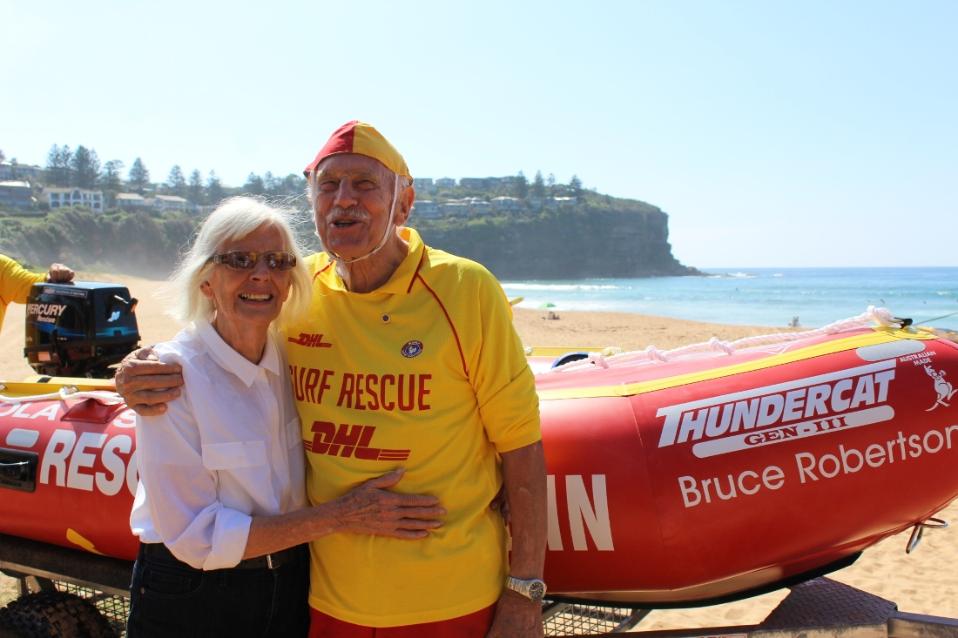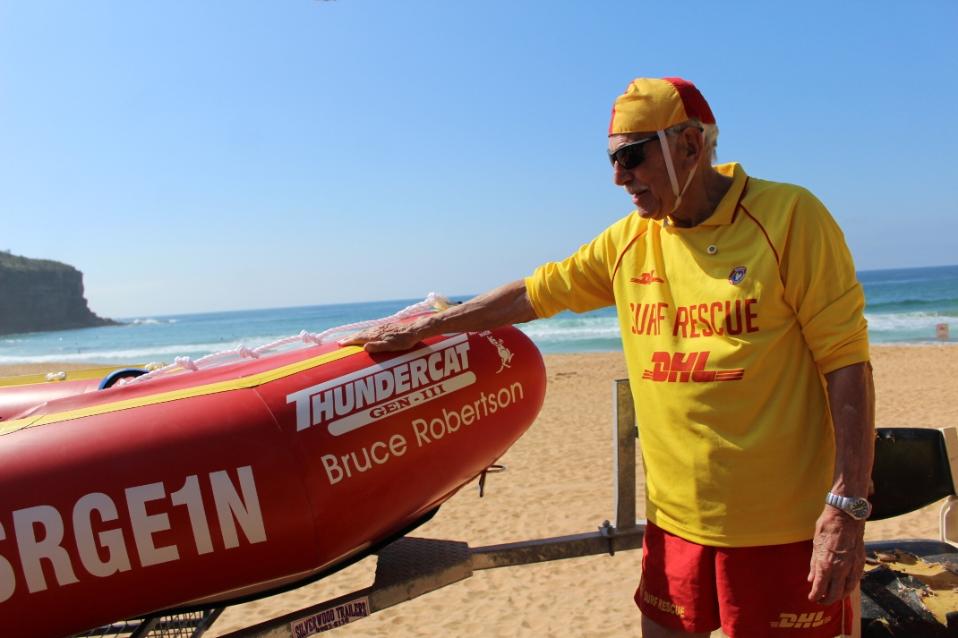May 6 - 12, 2018: Issue 358
Bruce Robertson OAM
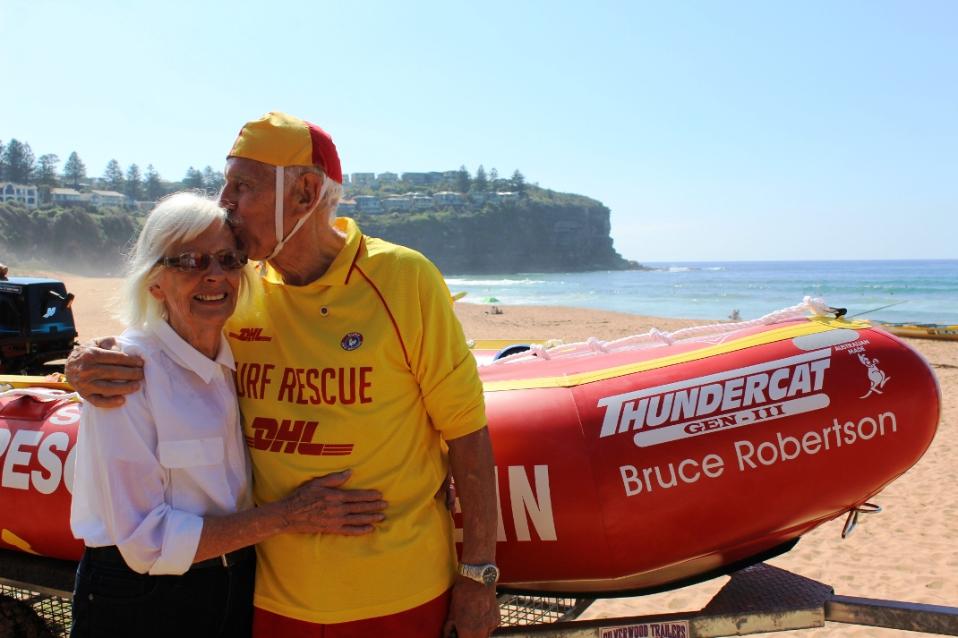
Gladys and Bruce Robertson
A few weeks back Bruce Robertson reluctantly ceased being an active Patrol Member for Bilgola SLSC after almost eight decades of service. A Celebration at the clubhouse for the Bilgola Life Member was the occasion of unveiling a new IRB presented by the Blackmore Foundation and named for Bruce which is probably getting a double christening this weekend as the Surf Life Saving NSW IRB Premiership commences. This will be the first time Bilgola competes in the prestigious Autumn-Winter rounds and also the first time Mona Vale, where Bruce commenced his service as a volunteer lifesaver during WWII, competes too. Something Bruce would be happy about seeing as he is a year-round happier being active person.
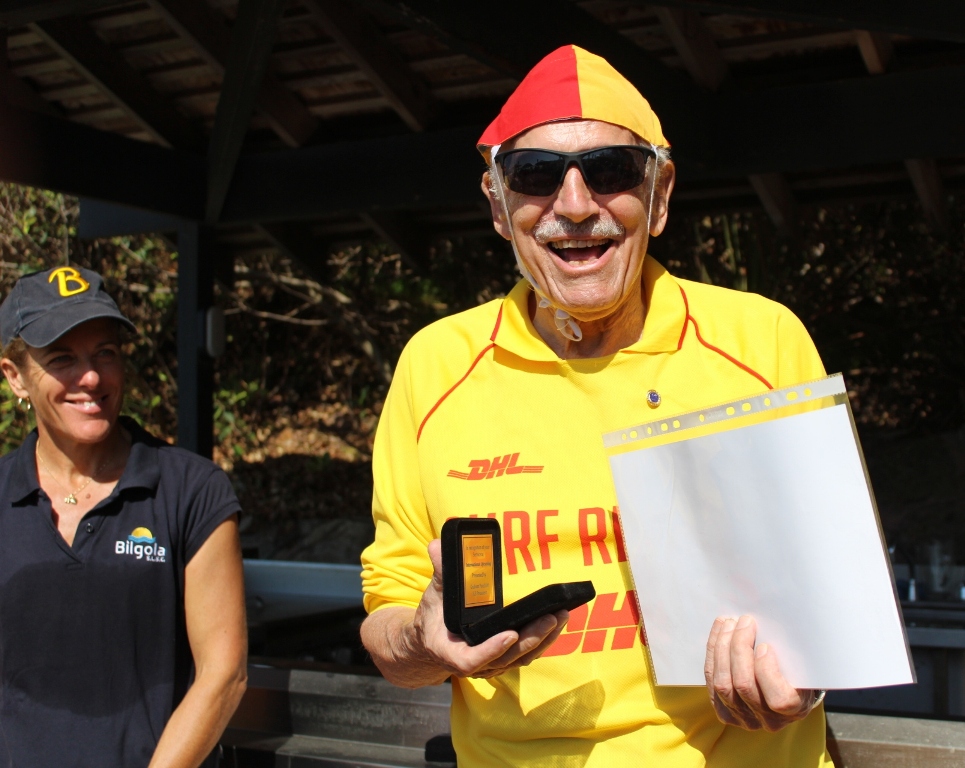
President of Bilgola SLSC Romilly Madew and a delighted Bruce Robertson OAM
In fact, when you peruse the list of works done by Bruce when nominated and receiving an OAM in 2008 as part of the Queen's Birthday Honours, you can see he has filled life to the brim with doing for others, atop of being a father and husband.
That List:
ROBERTSON, Bruce Norman Awarded OAM on 09 June 2008
‘For service to the community, particularly through the Keep Australia Beautiful Program.’
Volunteer Director, Keep Australia Beautiful (NSW), since 2000; Treasurer, 2000-2003.
Adviser, Keep Australia Beautiful National Association.
Vice-President, Committee of the Friends of the Royal Botanic Gardens Sydney, 2002; Member, 1997-2002; active Volunteer, 1997-2007.
Trustee, Botanic Gardens Trust, 1997-2000.
Chairman, Zoological Parks Board NSW, 1990-1996; including responsibility for Taronga Park Zoo and Western Plains Zoo.
Initiator and now active worker for Sydney Great Ocean Walk; 65km pathway from Palm Beach to the Royal National Park, Bundera.
Member, Chatswood Oval Management Committee, Willoughby Council, 2000-2005.
Director, Gordon Rugby Club, 1996; Board Member and player.
Chairman, Gordon Social and Recreation Club, 2005; Director, since 1995.
Founding Member, Rugby Ski Club; Chairman, 2001-2004; Honorary Director responsible for Club building program.
Member, St Ives Rugby Club, for over 30 years; Secretary, Coach and Manager of junior teams.
Life Member, Bilgola Surf Lifesaving Club, 1999; Vice-Captain, 1955; Member, since early 1950s.
Member, Ku-ring-gai Toastmasters Club, 1974-1978; and responsible for Youth Leadership Program.
Treasurer, Bradfield Conference, NSW Liberal Party, for 22 years.
Member, NSW Liberal Party's State Council.
Supporter, ‘Old Falconians Union’ fundraising body, North Sydney Boys High School.
NB: Australia Paper and Cardboard Fact Sheet September 2009 – Clean Up Australia
A list of works done doesn't give the insight speaking with the person whose list that is though, especially when that person has crammed 87 years of living to the utmost into each day and has lived through many interesting times.
When and where were you born?
At Kensington, here in Sydney, in 1930.
ROBERTSON (nee Garnett).—August 4, at St. Ronan's private hospital, Borrodale-road, South Kensington, to Mr. and Mrs. Norman Robertson, Kensington-a son (Bruce). Family Notices (1930, August 9). The Sydney Morning Herald (NSW : 1842 - 1954), p. 14. Retrieved from http://nla.gov.au/nla.news-article16706960
Where did you grow up?
In Roseville. It was a great spot to grow up in. We were over towards the railway lines and the developers had been through there in the early 1920’s so there were houses around us.
Where did you go to school?
At Roseville Public school and then North Sydney high, the boys school. This was a very good school.
Didn’t that school have links with Duntroon?
A lot of chaps went onto Duntroon like I did. Just after WWII the Army was keen to get new men trained. During the war we naturally paid a lot of attention to what was going on. My father, Victor Norman Robertson, was in the Army and he was away at Dubbo. So it was quite natural to get involved, which I did.
During the war I was a messenger boy for the Air Raid organisation at Roseville. This was exciting work. I must admit I was never frightened of the Japanese, I didn’t think they could really get here (to Sydney) but at the same time, that’s exactly what was happening.
What happened at Mona Vale Beach in terms of preparation was one clear example of this. They had an enormous barricade of barbed wire set there.
To prevent or stall a feared invasion by Japanese forces, a tank trap was built across the course from Turrimetta to Mona Vale heads and barbed wire entanglements erected next to the beach. An influx of defence forces meant La Corniche was utilised while Mona Vale Golf Club's clubhouse was commandeered for use as administration offices and officers’ mess for the nearby army camp.
AIR SIREN TEST, THURSDAY
Commencing at 2.30 p.m. on Thursday, air raid sirens will be sounded in a sequence of. 10 seconds "on" and five seconds "off" for three minutes. The Minister in Charge of National Emergency Services (Mr. Bruxner) said to-day that tests had been made in the country with one of the sirens, and that it had been decided to change slightly the sequence, to give the greatest effect of a walling note that could be produced by the full power of the sirens. After the sirens had been sounded for three minutes, there would be an interval of five minutes, and the "all clear" signal would be given. This would be a continuous blast for two minutes. Test In Wide Area The nine fixed sirens, said the Minister, were installed on the tops of the following buildings: — Amalgamated Wireless tower; a Maritime Services Board building overlooking Darling Harbor; the Registrar-General's Department, King-street; Byron Hall, Macleay-street; Belgenny Flats, Taylor Sauare; David Jones's factory, Redfern clock tower, Central Railway Station; a wool store overlooking Blackwattle Bay; and at Fort Denison. The sirens, of 47 fire brigade engines would be set in action in the suburbs in front of fire stations. Police cars located at Roseville, Lindfield, Killara, Turramurra and Wahroonga would sound their sirens. The test area is from Palm Beach to Liverpool to Cronulla. AIR SIREN TEST, THURSDAY (1940, February 20). The Sun (Sydney, NSW : 1910 - 1954), p. 3 (LATE FINAL EXTRA). Retrieved fromhttp://nla.gov.au/nla.news-article231239542
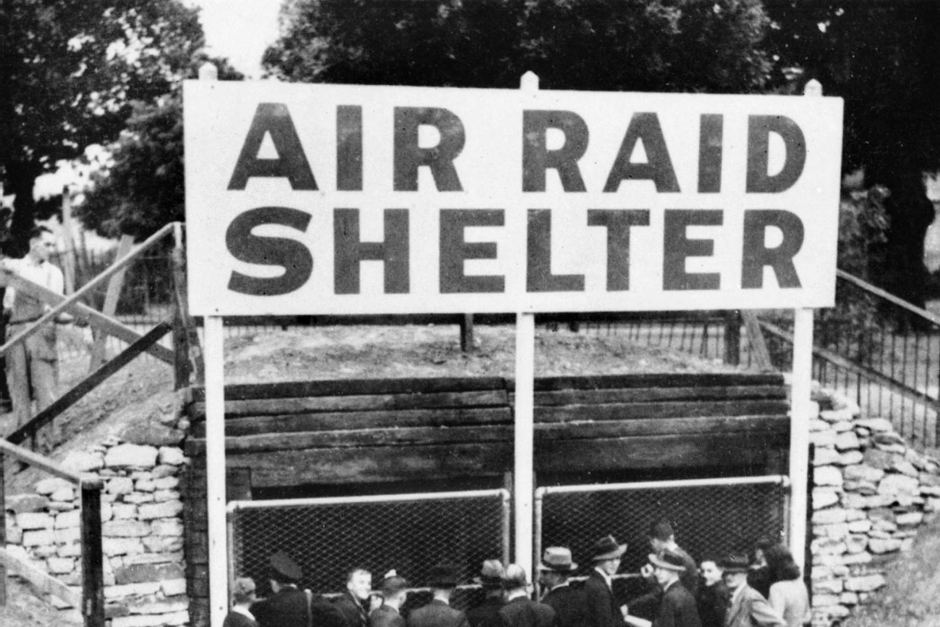
An air-raid shelter in Sydney's Hyde Park. Courtesy Australian War Memorial
Do you remember the evening Sydney Harbour was bombed by Japanese mini-submarines?
Do I ever. The place shook with all that was going on. See Roseville wasn’t that far away and the house was shaking. What was happening was the depth charges were landing on the bottom of the harbour, on to the rock, and that was transferred through the sandstone Sydney is built on. That’s why we felt it, as did other places up along the North Shore.
How old were you when you got your Bronze?
I was underage, even though I got my medallion, so it wasn’t official. They were so short during the war that they allowed chaps like myself and others to help out. Of course, during that time and circumstances you found you matured early, I certainly did. At 14 I was already six foot which gave me a big advantage at that age.
How did you come to Mona Vale originally?
Through talking to Rod Taylor, when we were wrapping papers, we’d talk about what we were doing. He was doing art at Sydney Technical College and I was still at school. We used to wrap all the newspapers and periodicals for Swains, which was a big stationer in Pitt Street in Sydney. This was in 1941 and 1942, I was 11 and 12.
We were both keen on the surf and said one day ‘let’s have a look’. So we decided we’d get the bus where we could, caught a bus and went as far as the bus would go which was Mona Vale. We walked down to the beach and that was it.
About 14 or 15 of us used to sleep on a big wrestling mat in the middle of the floor. The first clubhouse had gone up three or four years prior to that.
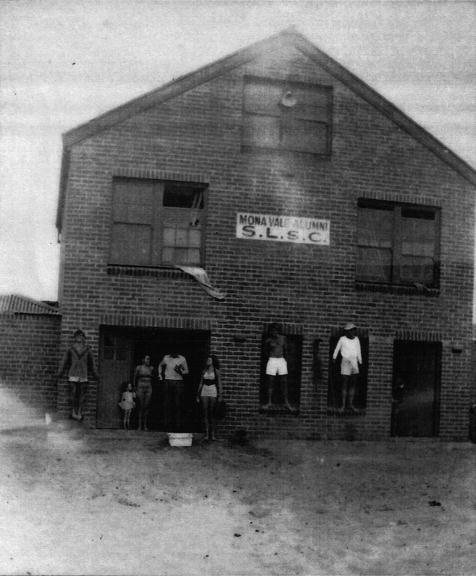
How did you get from Mona Vale to Bilgola?
By that stage the bus route to Mona Vale had been extended to Palm Beach. I went and had a look at them all of course but liked the look of Bilgola, so I got off there.
Bilgola surf club hadn’t started then. There was talk that they were going to have a surf club there and when they started to build it I went and helped with the building while I was still at Mona Vale SLSC.
%20of%20Frank%20Hurley%20Bilgol%20Newport%20Bungan%20shows%20Bilgola%20SLSC%20being%20built%20circa%201950.jpg?timestamp=1499902325524)
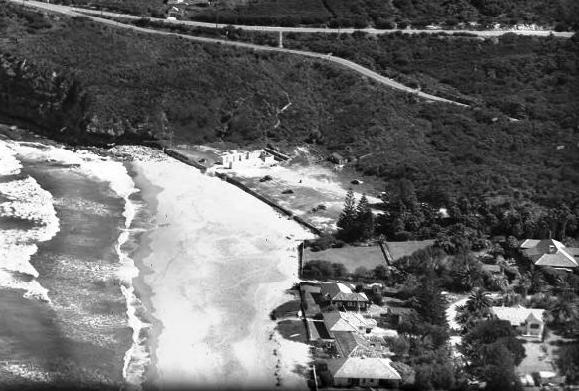
Frank Hurley photo, circa 1950-1953 and section from showing clubhouse under construction courtesy National Library of Australia
Didn’t you row for Mona Vale?
Yes, I rowed in the surf boats. They went to Hawaii prior to the war in a contest between the Hawaiians and Australians. They took that surf boat over there, so it was good to be part of that.
Duntroon – how old were you when you first went there?
18. I was there for four years and graduated as a Lieutenant. While there I played rugby with the Combined Services side against New Zealand and also played for Canberra on the A.C.T. side.
PENALTIES GIVE DUNTROON LEAD
Two penalties gave Duntroon a six-nil lead over Combined G.P.S. at half-time in their Rugby Union match at the Showground today.
Duntroon: J. D. Kelly; A. M. McDonald, A. E. Goodall, A. E. Breen, W. E. B. Kinlyside; A. T. Mataira (captain), A. McDermott; W. B. James. C. N. Khan (vice-captain), D. S. Johns, E. Boyd, B. N. Robertson, R. G. Williams, M. B. Pears, R. W. Meadows. GPS: I. Sharrack; R. J. Scarf (vice-captain), J. Massey, H. H. Hawker, H. J. Prell; M. Adare, W. R. Fisher, J. M. MacCallum (captain), T. M. Williams, J. Schneider, R. Butler, J. Clelland, I. Gordon, B. Gell. P Baker. Referee: H. J. Kahl. Just after the start the ball went to five-eighth Mataira, who cut through, ran brilliantly and passed to Breen. That player sent Goodall over in the corner. Williams missed. Duntroon Duntroon 3-nil. A scrum infringement gave GPS a chaij.ce to equal, but Baker ...
GPS moved into DuntrOon's territory and winger Scarff just failed to collect on Duntroon line. Full-back Kelly got Duntroon out of trouble with . a crashing run. From a penalty, Kelly took play into the GPS half with a nice line kick. Duntroon then made another fast back line move, but Breen knocked on near the line. GPS forwards then were prominent, MacCullum, Williams and Gurdon making short dashes. GPS' backs were passing well, but the Duntroon defence forced them to run practically across field. Duntroon full-back Kelly was playing a splendid game. He beat three defenders and kicked to catch Sharrock in possession on his line. However, Sharrock wisely stepped outside, the line. Then Baker missed from a penalty from 40 yards out. Khan headed a forward rush into the GPS half. Mataira tried to go through on his own, but was tripped up with the line wide open. Duntroon half-back, McDermott, from a five yards scrum tried to go round the base, but was stopped solidly -GPS was allowing Mataira to cut through, making the extra man. Hawker propped and cut infield, but he was downed by the Duntroon cover defence. A penalty close in saw Williams raise the flags. Duntroon 6, GPS nil: Duntroon 6. GPS I. nil.
In the second half GPS scored after a neat move. Winger Sundstrup ran hard along the blind side, sent to Romalis, to Jones, who scored under the posts. Romalis goaled. GPS 8, Hawkesbury 3. Hawkesbury now was constantly on the attack. Full-back Mason cut through and then passed to McFarlane, who scored under the posts. Lee converted. GPS 8, Hawkesbury 8. From a scrum in Hawkesbury 25 the ball went from Taylor to Romalis, to Jones, to Sundstrup, who scored in the corner. Romalis missed the goal. GPS II 11 (R. Jones, B. Sundstrup tries, N. Romalis goal and penalty goal) beat Hawkesbury Agricultural College 8 (B. McFarlane try, J. Lee goal and penalty goal), at Showground.
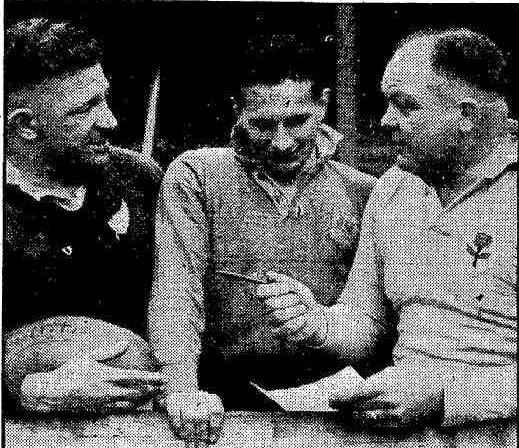
WALLABY selectors Bill Cerutti (left), Trevor Allan, and Ron Walden at University Oval today, where they chose the team for the Wallabies' first match in N.Z.
PENALTIES GIVE DUNTROON LEAD (1949, August 13). The Sun (Sydney, NSW : 1910 - 1954), p. 7 (FINAL FOOTBALL LAST RACE). Retrieved from http://nla.gov.au/nla.news-article231055818
HUMOUR IN BAD TASTE' COSTUMES
Forty members of the A.C.T. Rugby Union Football Club were entertained by Wollongong players at a 'Come in bad taste' party at the Agricultural Hall on Saturday night. Wollongong Club celebrated a 22-19 victory over the Canberra team in the last match of the season.
Ten members of the Canberra team, including captain Bruce Robertson, were from the Royal Military College, Duntroon. The president of the Wollongong Club (Dr. Tad McGovern) set the example of bad taste with a Hawaiian shirt, formal evening suit and black beret, while Mrs. McGovern wore a smart cocktail jacket and hat with slacks. The master of ceremonies, Mr. Guy Baker, appeared in dinner jacket and football shorts. Wollongong trio, the Dwyer brothers, were the vocal artists. HUMOUR IN "BAD TASTE" COSTUMES (1951, September 17). Illawarra Daily Mercury (Wollongong, NSW : 1950 - 1954), p. 4. Retrieved from http://nla.gov.au/nla.news-article135798749
In 1911 The Australian Military College (RMC) was established at Duntroon in Canberra in 1911. Very quickly, rugby Union emerged as the dominant sport played by cadets and staff. The importance of Duntroon to rugby in the whole of the Monaro was highlighted when, as a cost cutting measure in the Great Depression, the RMC was moved in 1931 to Sydney and little rugby was played in the district until the College was moved back to Duntroon on 1937. That year of 1937 is regarded as the beginning of Australian Capital Territory rugby with Duntroon as the spark. From: http://www.nswcountryrugby.com.au/about-us/history
RUGBY UNION
This Saturday the Tigers journey to Canberra to do battle with the strong Duntroon side. At present, Duntroon are on top in the Canberra competition and are keen to score a win over Wollongong, as last year Wollongong scored a surprise Win over a conjoined A.C.T. side which included ten Duntroon players. The R.M.C. captain, Ian Way, when contacted recently, said that his side will be all out to prove that their defeat at the hands of the Tigers last season was not an indication of the strength of Canberra football, and they will prove their superiority on Saturday. The Wollongong XV has been hampered tills season by a lack of hard matches, having scored over 306 points, with only 43 against in their games to date. A feature of these matches has been the defence of the Wollongong back row forwards, Terry True, ex-Eastwood breakaway, George Tipper and Bob Crockart, who gained their experience with the University. To these forwards add the seasoned Fallick and Atherton, and the hooking ability of Athol Webb, and a - good side will be needed to down Wollongong. Both sets of forwards average over 13 stone per man, and as the Duntroon pack includes Country reps. Bruce Robertson and Ron Meadows, the clash between the two packs should prove the highlight of the game. RUGBY UNION (1952, August 21). South Coast Times and Wollongong Argus (NSW : 1900 - 1954), p. 30. Retrieved from http://nla.gov.au/nla.news-article143092045
Duntroon Cadets Graduate
CANBERRA, Tuesday.
The Minister for the Army, Mr. J. Francis, today presented trophies and diplomas to 37 cadets who have graduated from the Royal Military College at Duntroon. He inspected the Cadet Battalion and took the salute at a march-past.
The N.S.W. graduates are: D. A. Drabsch. Guyra; E. H. Hynes, Earlwood; R. W. Meadows, North Sydney; M. J. H. Bird, Moorland; B. J. Harper, Double Bay; B, L. Nyman, Dover Heights; T. L. Reed. Mosman; B. N. Robertson, Roseville; T. R. Harwood. Burringbar; B. C. Gray, Marrickville.
Addressing the cadets, Mr. Francis said that Australia, in common with the other nations of the British Commonwealth and its friendly allies, should build up its defences to deter any aggressor from the thought of war, especially as recent developments in atomic and scientific warfare had greatly increased the speed with which a modern aggressive force could operate at maximum efficiency. Duntroon Cadets Graduate (1952, December 10). The Sydney Morning Herald (NSW : 1842 - 1954), p. 5. Retrieved from http://nla.gov.au/nla.news-article18294527
39 CADETS TO GRADUATE AT DUNTROON TO-DAY
Graduation Day will 'be held at Duntroon to-day, when 39 cadets will take part in the parade, receive their diplomas, and then be feted at the Graduation ball at the Royal Military College at night. The Minister for the Anny, Mr. .T. Francis, will take the salute in the march past, and present the College trophies and diplomas.
The class is the 46th to graduate from the College.
The Parade will be watched by the High Commissioner for the United Kingdom (Sir Stephen Holmes), and Lady Holmes, and other members of the diplomatic corps. Among onlookers will also be Lieut-General S. F. Rowell, Lieut.-General H. Wells, and Major-General E. W. Woodward.
Three former graduates of the College will see their sons following in their footsteps. They are General Wells whose son is Col-our Sergeant A. D. Wells; Lieut.Col. A. L. Nyman, assistant Adjutant-General Headquarters Comand Eastern Command and his son Cadet Cpl. B. L. Nyman, and Licut.-Col. D. A. Hail and his son Cadet Cpl. A. T. Hall. Approximately 400 guests, from, all eastern states, will attend the Graduation Ball at night. Students will go on leave on Wednesday. 39 CADETS TO GRADUATES AT DUNTROON TO-DAY (1952, December 9).The Canberra Times (ACT : 1926 - 1995), p. 1. Retrieved from http://nla.gov.au/nla.news-article2870440
How did you meet Gladys?
I met Gladys on Bilgola Beach.
Gladys: we met here at Bilgola. I would always swim in the surf, never the pool.
Our family had an original place at Palm Beach, or my father Mr. Murray did, it was just a shack. Then he bought a block of land at Whale Beach, just as you go around the corner. He built a place there and then he bought next door as well. So there were two pretty basic little holiday places. We had them and that’s where my kids grew up.
I had a twin sister, Ev (Evelyn) though and we’d come to Bilgola because this is where the action was.
All the good guys were here, Sonia McMahon and her sister, the Howe family and the Over family.
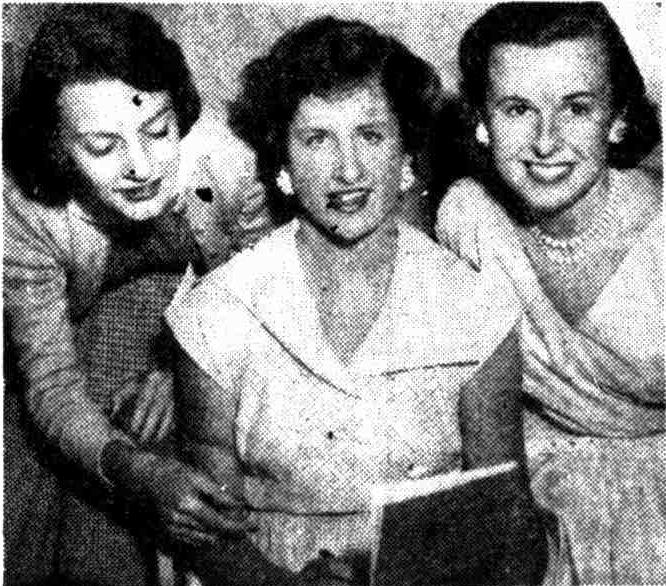
Discussing plans for the New Year's Eve party, organised by the Bilgola Surf Lifesaving Club, are members of the ladies' auxiliary, EVELYN MURRAY, of Gordon, ROBIN KEENE, of Roseville, and HELEN JACKSON, of East Lindfield. Women's News and Gossip (1954, December 23). The Sun (Sydney, NSW : 1910 - 1954), p. 22 (LATE FINAL EXTRA). Retrieved from http://nla.gov.au/nla.news-article232000409
Was Bruce already doing patrols here then?
I can remember him here. He was in at Duntroon for four years until he graduated. But I recall when he was here he had the Flag Carriers job and was always at the head of the march. He was head, or ahead, of everything really.
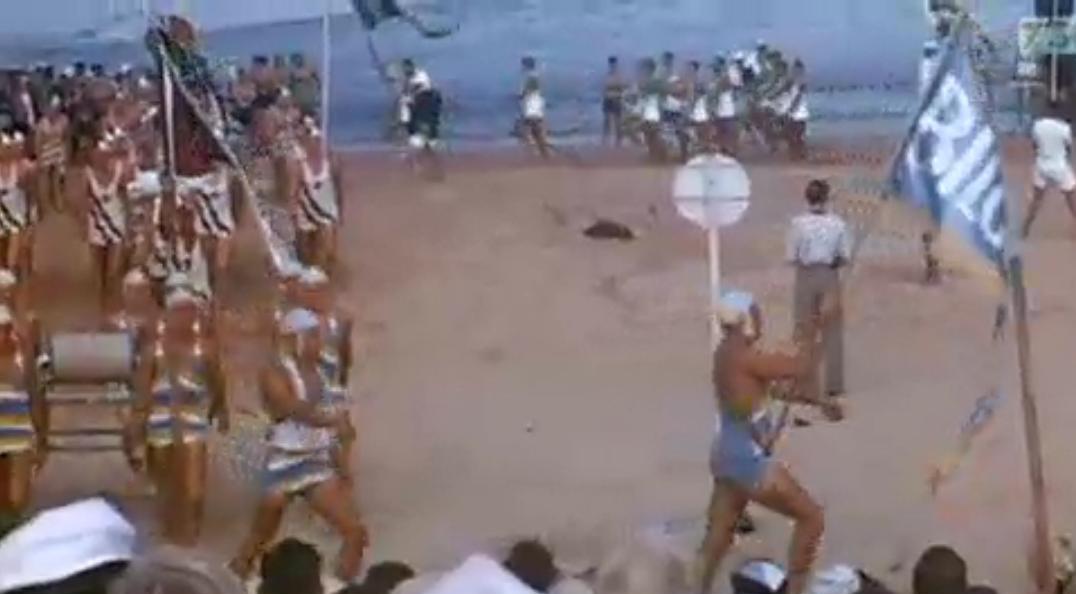
Bruce, Flag bearer for Bilgola SLSC at 1954 Bondi Carnival for Queen Elizabeth II
What did you think when you first saw him?
Gladys: oh, I thought he was pretty gorgeous. And he was, he was a very good looking guy. He looked tough but was very kind.
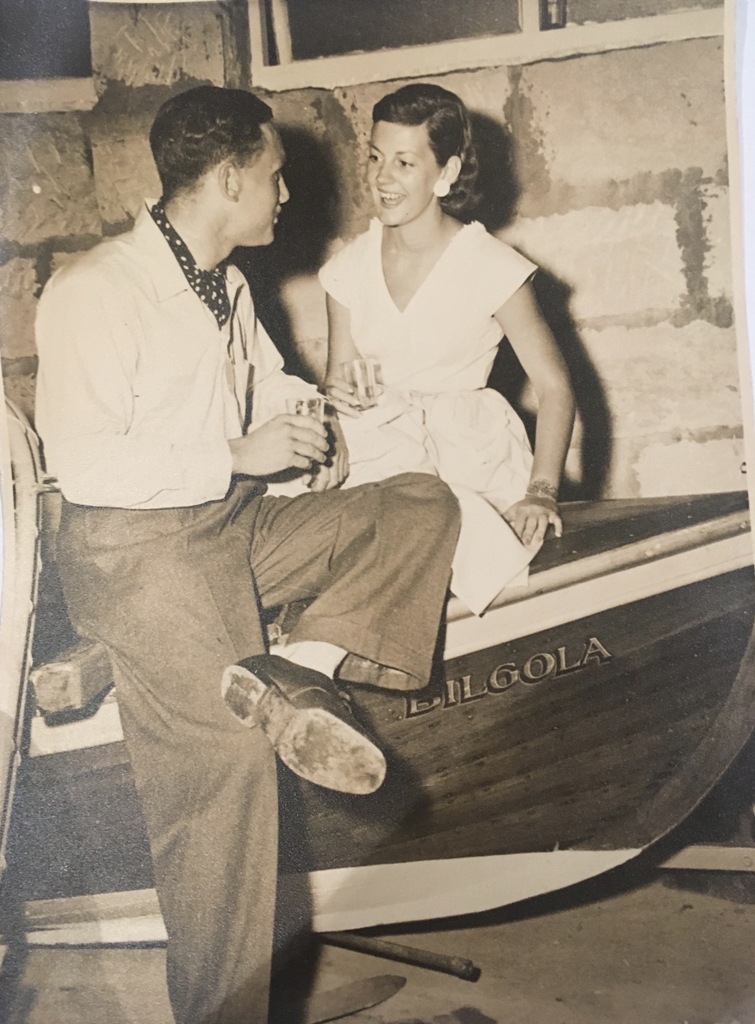
Bruce and Gladys at Bilgola - circa 1954
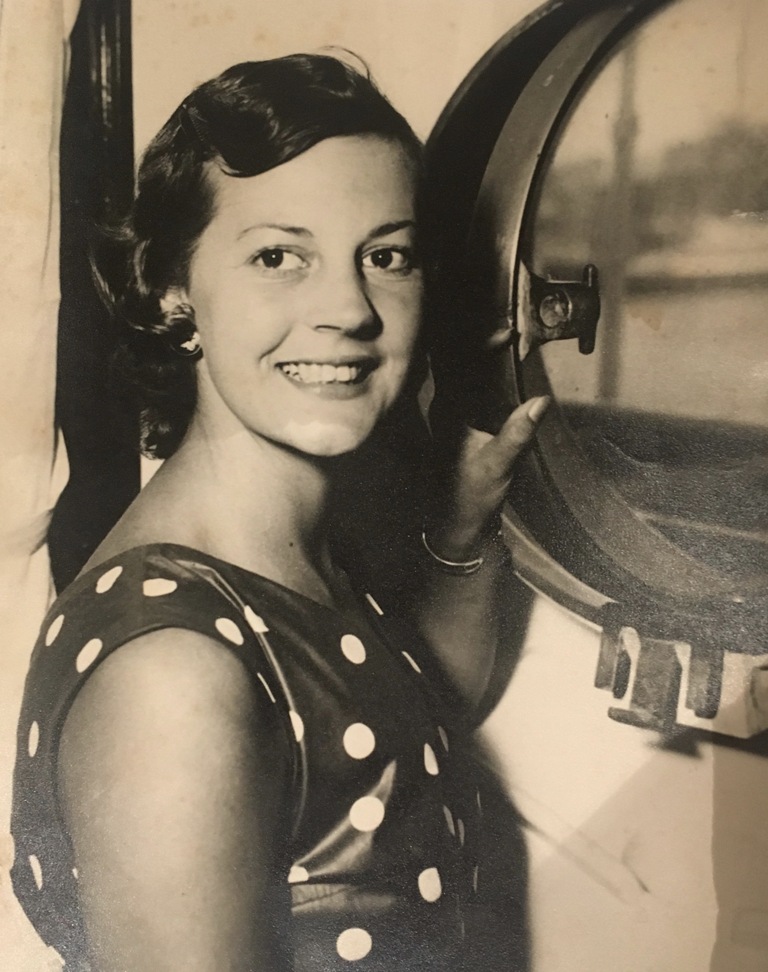
Gladys circa 1952
Bruce, what did you think when you first saw Gladys?
I thought she was very attractive, gorgeous. We married in 1956.
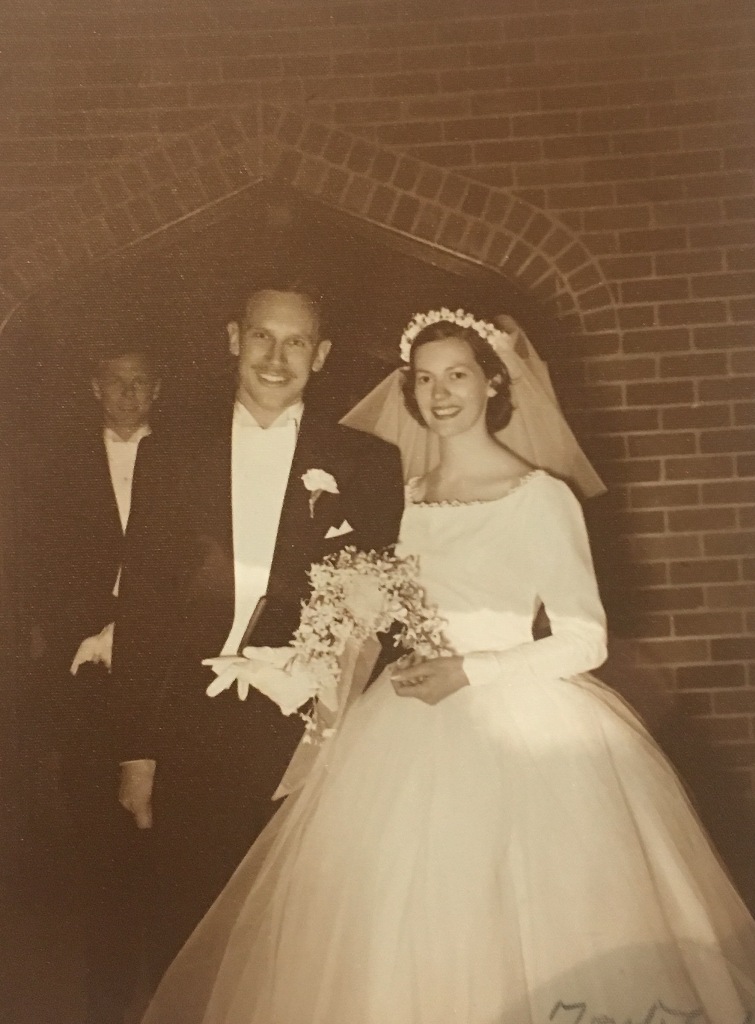
Wedding day
What did you do after you graduated from Duntroon?
We were training to go to Korea and then the war came to an amnesty situation and I decided if I was going to get out of the army that I’d do it then. I resigned my Commission and was 24 by then.
I joined James Hardie, the fibre cement manufacturers. I started off in marketing and was transferred to Victoria where I became Victorian sales manager.
I married Gladys in the meantime and my father-in-law wanted me to come into business with him and so I went into business with him and represented a Canadian company in making paper machine wires.
Mr. Murray had paper agencies and also these paper machine agencies. These are the felts and the wires that were used to make paper. I looked after wires. There was a Canadian company that we were the agents for and I had to go over and learn all about it and so went to Canada for three months, to Ottawa. They had plants in Quebec and Vancouver.
Originally we imported the wires from Canada but the business was considered so good, with great future prospects, that we decided to build the wires within Australia. I was placed in charge of building the plant here and decided the best place to put this would be along the northern beaches area and so bought 5 acres at Dee Why. There we established Capital Wires. This was all up and going in two years and in there we also started to draw wire, which is producing wire for the rods. We’d buy the rods and put these into the machine and draw the wire out which they then wove into the mechanisms used for making paper. This was a 24 hour operation, 7 days a week at Dee Why. These were then sold all over Australia and New Zealand.
I did this for 10 years and then took on the position of General manager at Royal Doulton, who had a plant at Chatswood.
I was there for three or four years and then Hardie’s asked me to come back again. They sent us to Melbourne. We were there for four years.
Where in Melbourne were you living?
Moorabbin – I bought the show home we had there during that time. Melbourne, at that stage, was enamoured of the cream brick veneer style of home. These extended from Balwyn right down to Franskton – they were all cream brick veneer. This was after the war, that’s all they had.
We built this fibro home, an architect designed very smart home but Melbourne people were very anti anything other than cream brick veneer; it was gospel down there and a sign of success.
Did you get near the coast while based in Melbourne?
No, I was flat out. We still went back to the club (Bilgola) during Christmas time and did a lot of Patrols to try and keep up my Membership, which I succeeded in doing.
Where does the Senior Executive position at Hardie Grant books come in?
Hardies was growing very quickly during that period and diversifying. We bought a publishing business, which had been established at Dee Why once again. I established the Head Office in Sydney. They also went into making films too.
How did you become involved with Taronga Zoo and then become Chairman?
Through politics. I did take an active interest in the Liberal Party and was president of the St. Ives Branch so that brought to my attention what was going on in the Northern suburbs. We lived at St. Ives then, a beautiful spot, lovely and green.
Tim Moore, who was the Member for Gordon, had seen me working in the Liberal Party and he approached me to see if I’d be interested in taking on a few other roles. At that point in time this wasn’t a fulltime job, just works undertaken to support what Taronga was trying to do. I went on and in the fullness of time I was appointed Chairman. I went on from there and took on the role of being a Trustee of the Royal Botanic Gardens in Sydney as well.
Weren’t you also instrumental in creating the Coastal walkway?
Yes; I was very keen on that. I think Sydney is the most fortunate city in the world in having these areas and to provide a walkway that allows people to have access to them is something that allows everyone to benefit from this.
What projects were occurring at Taronga while you were Chairman?
We had building projects, improving the setup as well as bringing in new animals. At that stage Dubbo was being expanded too – so we got Dubbo established, and we were successful in raising 7 million dollars to bring in Rhinos and establish that species saving program as well as a compound for them.
This was also the second time I cam into contact with Queen Elizabeth II, who visited on a tour here in 1992.
Queen Elizabeth II visited the Western Plains Zoo on February 21, 1992. The region demonstrated its affection for the Queen with 25,000 spectators lining the streets to cheer and wave as she passed through town. About 4000 school children from across the region gathered at the Western Plains Zoo during the 1992 visit to greet the Queen as her motorcade passed through the facility. The zoo put on its best face for the Queen with feeding times rescheduled to coincide with the royal tour, to ensure all the animals were at the front of their enclosures as her Royal Highness passed by.
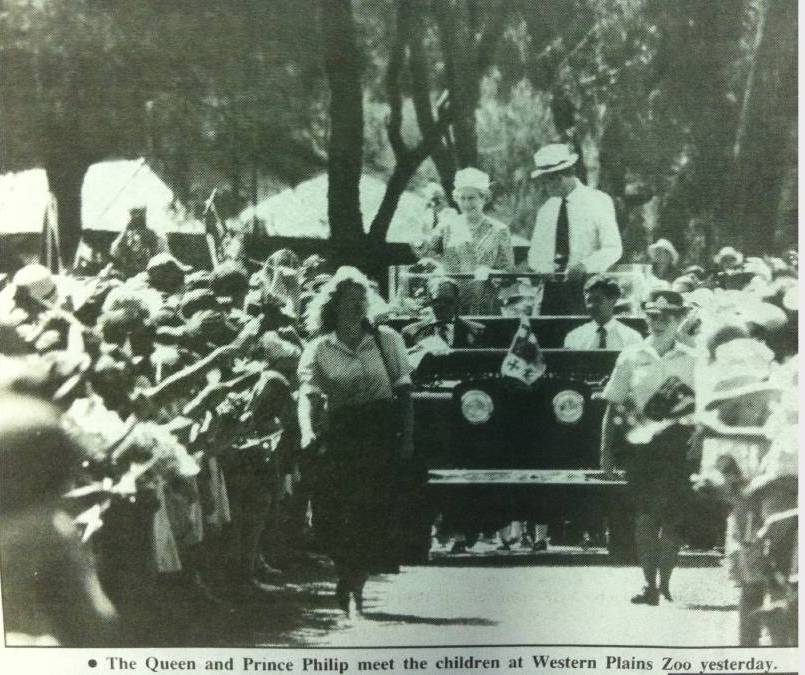
Clipping – Daily Liberal, for February 21, 1992 visit.
Taronga Western Plains Zoo, formerly known as (and still commonly referred to as) Western Plains Zoo and commonly known as Dubbo Zoo, is a large zoo near Dubbo, New South Wales, Australia. It opened to the public on 28 February 1977, to provide more living and breeding space for large animals such as elephants and antelopes which needed more space than was available at the restricted Sydney site. The zoo is run by the Taronga Conservation Society (formerly Zoological Parks Board of New South Wales), along with Taronga Zoo Sydney. Western Plains Zoo is located on the Newell Highway in west Dubbo about 4 km from the city.
In 1994 Western Plains Zoo was awarded as the Best Major Tourist Attraction, the highest honour in Australian Tourism.
Recently celebrating 40 years https://taronga.org.au/taronga-western-plains-zoo/happy-birthday-the-zoo
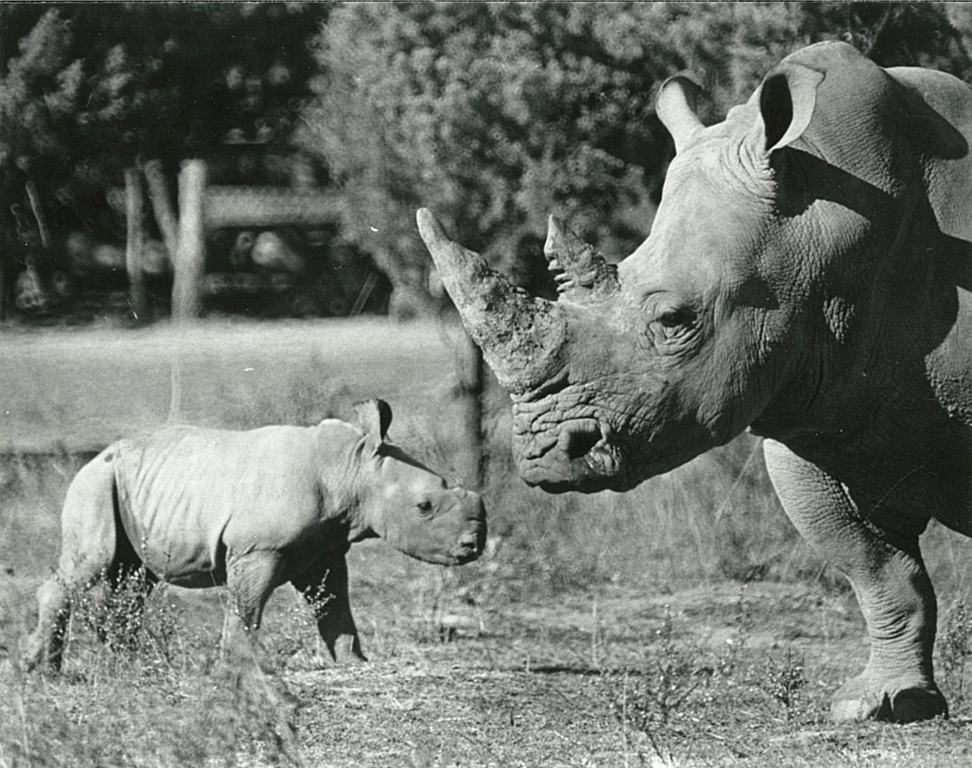
Photo: The Zoo has long been associated with rhinos. Here is one of the first White Rhino calves born at the Western Plains Zoo. Courtesy Taronga Zoo
The RBG of Sydney has recently celebrated its 200th anniversary – what was it like being part of that?
I wasn’t too highly involved in the upper echelons there – there was in place, and still is, a great bank of highly trained professionals who look after each area associated with these gardens. There were some interesting challenges during my tenure and I enjoyed it immensely.
I took the opportunity when on my business trips overseas to make a point of going and seeing the principal gardens of the world and ours compares quite favourably. This also, through the broad spectrum of what has been created elsewhere, was pretty helpful in my role of being Chairman of the Royal Botanic Gardens in Sydney during the period I was.
Did you have any favourites while overseas?
Oh, yes – the Cotswolds were wonderful, also Oxford. There were also some great ones in the United States and Canada.
Getting back to Surf Life saving – being Flag Bearer for Bilgola at the 1954 Bondi Surf Carnival which Queen Elizabeth II attended– what was that like?
Wonderful. What was equally exciting was the size of the surf that day. It was monstrous.
I can remember one wave it took us three strokes to get over the wave. We didn’t get pounded there, but we did get pounded many other times.
Extra surfboat races were run off for The Queen's entertainment. During the visit the Royal Couple probably saw more action and more thrills than they will find on any other tour engagement.
A big surf was running, and there were mishaps in several races. In one senior surfboat race the four competing boats were capsized and the crews thrown into the water. In another race, three of the four boats were overturned by huge waves.
The Queen was so absorbed that she declined a suggestion to leave at the end of the scheduled half-hour. Throughout his stay, the Duke repeatedly swept the surf and beach events with his binoculars.
Shaded from the hot sun by a large white parasol. The Queen several times turned to officials, chatting merrily, and gasping as surfboats bucked the big surf.
The Queen and Duke were particularly impressed with the march past of 700 colorfully dressed surfers specially picked for the Guard of Honor because of their physique and bearing.
The march-past was made with pennants flying and to the skirl of pipes from the N.S.W. Police Pipe Band.
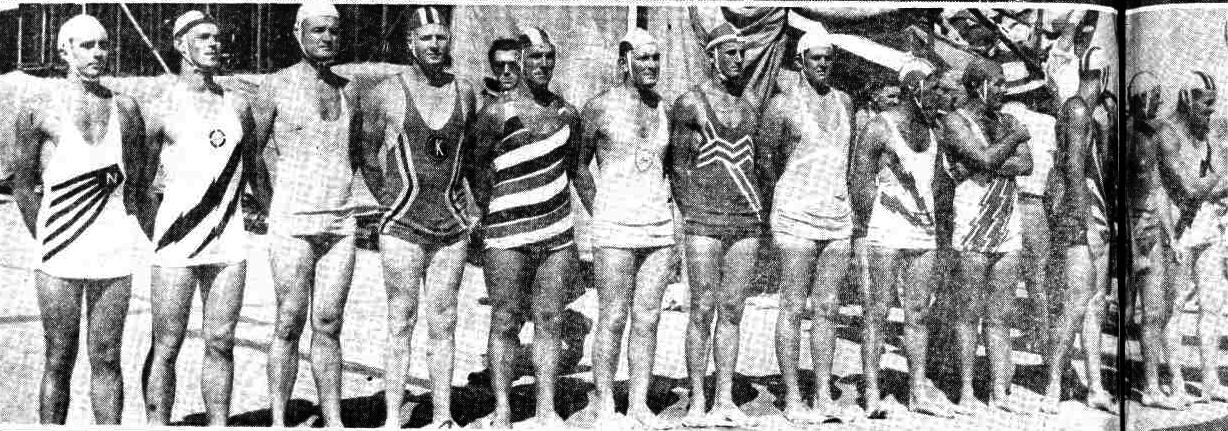
ROYAL TOUR THE QUEEN SEEN HER FIRST SURF CARNICAL OF TOUR (1954, February 12). The Land (Sydney, NSW : 1911 - 1954), p. 12. Retrieved from http://nla.gov.au/nla.news-article106917685
Which was the most challenging row while you were part of Bilgola’s Boat Division?
I would think North Narrabeen would be up there. I can remember being amongst a big surf there one day. And Harbord too, at Freshwater – we had some big waves during carnivals there too.
How long did you row for Bilgola?
At least six or seven years. We had and have a very good boat club there. We had Syd Fisher as our Stroke at one stage. He was pretty good.
The 1954 Carnival at Bondi wasn’t the only time you were near our Queen, was it?
No, I met her again when we were hosting her during a visit to the Dubbo Zoo when I was Chairman for Taronga. Unfortunately there was something going on between her and her husband so she wasn’t too happy that day and we didn’t get to talk. But there again is another outstanding marriage, something which has lasted, and there is clearly devotion between the two even now.
Yes Bruce – you wouldn’t stop kissing your own wife in between photos at the Bilgola celebration – you two are also clearly still in love with each other. What makes a successful marriage?
Yes, we are still very much so in love with each other. I don’t think it’s any one particular thing that keeps you in love for a lifetime. I think our parents showed us the roles we would play that works and we simply adopted that and it has worked.
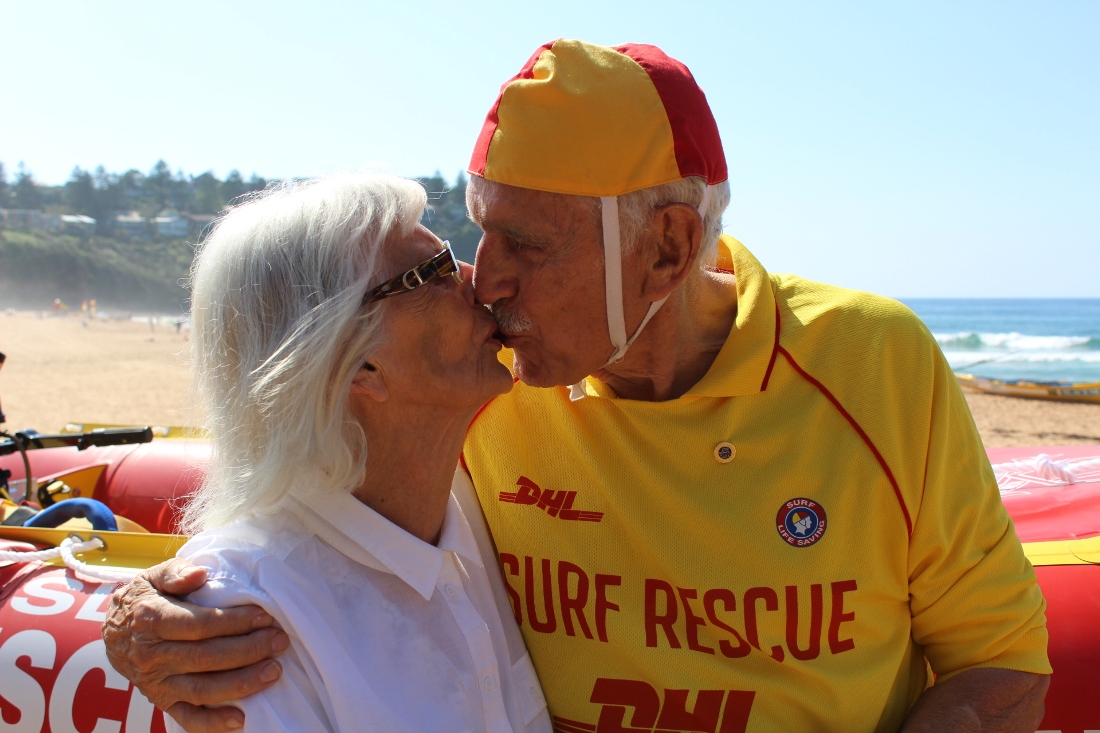
What other roles did you undertake at Bilgola?
The building and construction of the clubhouse was the big one really. All the members and some of those living there undertook to do this work so we could have some reasonable facilities available.
Many of the hands to do the work came from families who had holiday places there and these were also generous in allowing members to stay at their homes during their Patrols and during the construction phase of the clubhouse.
Once it was built we would bring a sleeping bag and simply stay in the clubhouse over the weekends we were Patrolling, especially those members who travelled from further away.
You’re just rounding out being one of the longest ever Patrol Members in Australia – how does that feel?
Good. The whole time, when we living in Melbourne for example, I would undertake doing as many Patrols as possible to keep my Membership up and you have to do so many Patrols and Patrol hours each season in order to do that. I love Bilgola, always have, and wanted to keep being a part of what happens there in serving others.
Mr. Ford AM (SLSA President)singled you out for praise at the recent Celebration of your Patrol decades, as did many others – you seemed delighted but still quite humble… why?
That was nice but really Surfing has always been a pleasure to me and has always been a relaxation to me. I have never let it get to the stage where it’s dominating my life. When Gladys and I married and had children clearly my family came first and my love of surfing came second.
So certainly Surfing was something I did and really enjoyed it for relaxation, and Patrolling as part of Bilgola was always part of what I did and wanted to continue to do to put something back, as were the other roles I undertook.
Rugby Bruce, you played at Duntroon and later at Gordon?
Yes, I represented Australian when at Duntroon, travelling to New Zealand. I played rugby too and was president of Gordon rugby club, so I had rugby too, for decades.
You are astoundingly fit for an octogenarian; would you attribute this to keeping up your fitness, both physically and mentally, to undertake these roles in lifesaving and rugby?
Well, it’s better to be fit than half sick.
One of the things I would always undertake, especially when travelling for work and which I think helps you when doing that, is to do exercise.
So wherever I travelled to I would always get up the next morning and go for a ten minute run. That ten minute run firstly would make me acclimatise to where I was and help me overcome the sleeping problems which can accompany travelling to different time zones, and it would also give you that time to think about what you were doing – it clears the mind and the body.
You mentioned at the Celebration of your decades of Patrols that you cannot drive anymore and no longer wish to prevail on family members to drive you Bilgola to fulfill Patrols – why can’t you drive there anymore?
This has become part of the new road rules – anyone over the age of 85 is approached in order to see if they’re fit to drive and in the majority of cases the emphasis is on taking the licence off that person.
Don’t people get the opportunity to take a test to see if they’re fit to drive?
No, that does seem to be part of it. I went to a Macquarie street specialist about an eye problem I had but that was treated and I got over it. Unfortunately it seems those in charge of a persons’ medical records are being encouraged to stop older people from driving.
For older people not being able to drive changes your life. You become less independent, more isolated at a time when you need the opposite. I believe in testing, I think people should be offered that in the first instance.
What do you love about Bilgola – you have been going there for a while now?
What I love about Bilgola is that it’s a beautiful place in its own self. It’s even more beautiful today than when I first saw it when it had a lot of big areas that were just grass, and not a nice kind of grass either. Now it has lots of big trees, especially the pine trees, have made a big difference. It’s a unique place, very special and I love it.
What is the best part of being involved with surf lifesaving – you have had a lot of experience there?
I believe they do a good job, a real job – saving people’s lives is paramount. Add to this looking after the beach and keeping an eye on making sure it’s used properly is also in there. This work has a challenge to it but it’s something that needs to be done.
To me the wonderful thing about surf lifesaving is that it has made it safe for people to go to the beach. I can remember people drowning – and this persists where people take risks or swim in areas that aren’t patrolled.
Today there’s drugs involved unfortunately. The thing about getting involved with drugs, especially if you’re going to get in the water, is that it lessens your capability and reasoning in getting out of any difficulties you may find yourself in and in some cases, is the cause of them to begin with.
Were there any difficult rescues you were a part of?
There was one when a person was caught in that rip that can go out to the point at the northern end of the beach. It was always mainly getting people out of rips for us. Most people who go to Bilgola know how to swim and they know the beach; its tides, where the rips can happen, where the sandbanks can build and form dumpers during low tides or as the tide is running out.
At Mona Vale, as it is placed geographically where you get so many other visitors not familiar with the beach, it being the first beach you can come to when driving down Mona Vale road, you have non-swimmers trying to catch a wave.
There is a deep channel there which can cause problems for those visiting.
I must say though that during the war there were other hazards causing problems, namely the amount of barbed wire placed there as a deterrent against any potential invasion. They had captured plans you see, plans made by the Japanese to use tanks in an invasion right along our coasts and so tank traps and barbed wire were installed. Every beach had these big concrete triangles, the waterways at Pittwater had them too.
We all had to go in and out of these. To go to the surf at Mona Vale during the war you went through two ‘S’s going round and in and out and then in and out again and add to these a series of barbed wire. My main activity then was giving First Aid to people and applying ointments and washing out sand from cuts from barbed wire.
MANLY, NSW. 1942-11-27. THE SEA WALL AND BARBED WIRE ENTANGLEMENTS ON THE BEACH FRONT. Courtesy Australian War Memorial.
You are a grandfather now – how many grandchildren?
Three and one of those grandchildren has a child on the way, so a great-grandfather too soon.
Do they like the surf?
Oh yes. My two sons surf, they have never been involved with surf lifesaving but have always been very keen Boardriders. They love surfing at Whale Beach, especially the south bank. I used to use a surf ski but have given that away now.
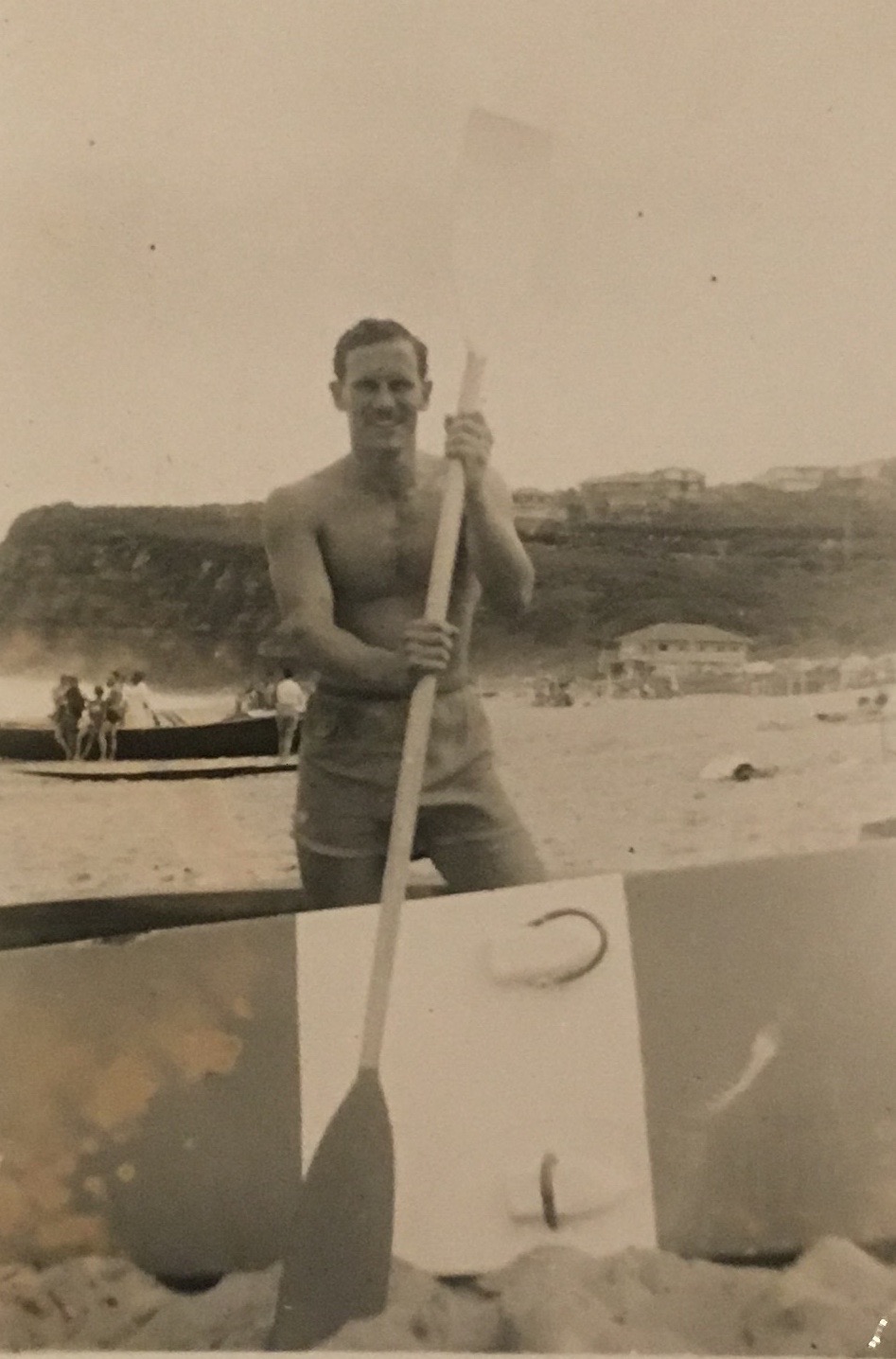
Bruce and his ski at Bilgola - circa 1960
What are your favourite places in Pittwater and why?
Bilgola, naturally, why; because it has so many wonderful memories for me. It’s where I met my wife, all those years and great fun being part of the surf club – so many things. There was always work to be done; building the clubhouse, letters to be written, there was always something so it was a swim and then work and then Patrols. You see Bilgola for a while had trouble attracting Members so we all did a lot more Patrols than you may find with the bigger clubs and more Members. Because we lived at St. Ives for so long being able to go there and be amongst that was a natural to me.
I’m still a Member now of course, and always will be.
What is your ‘motto for life’ or a favourite phrase you try to live by?
‘Never stop trying’.
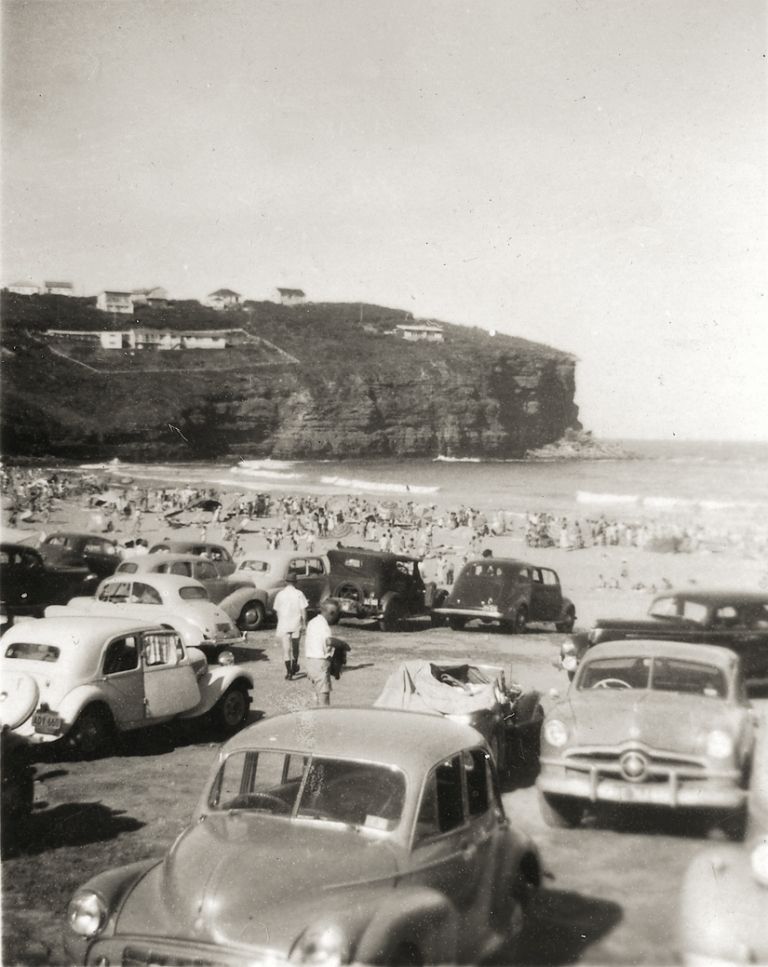
Notes
Bilgola SLSC Salutes Bruce Robertson's 76 Years Of Service: Lifesaving Legend and Australia's Oldest Active Member Hangs Up His Patrol Cap
Swains
Thomas Reginald Swain, who flew in the Pittwater Regatta's Aerial Derby (1900 to 1979) was the eldest son of Henry Charles Maitland Swain was born in 1873. In 1895 he established H.C. Swain & Company bookstore that was primarily a family business. Henry Swain's son, Arthur Newling (known as Michael or Mick, d. 1973) became a principle and managing director of the store. Initially located in Moore Street, the business moved to 121, 123, then expanded to 119-123 Pitt Street, Sydney, and incorporated an art gallery and rare books division. The name also changed to Swain & Company Pty. Limited. The Everglades in the Blue Mountains was purchased as a company acquisition of Swain's in the late 1950's. In July 1960 Swain's merged with Angus and Robertson. -- Reference: State Library of NSW's Field Librarian's notes Sept. 2003 and internal evidence from papers.
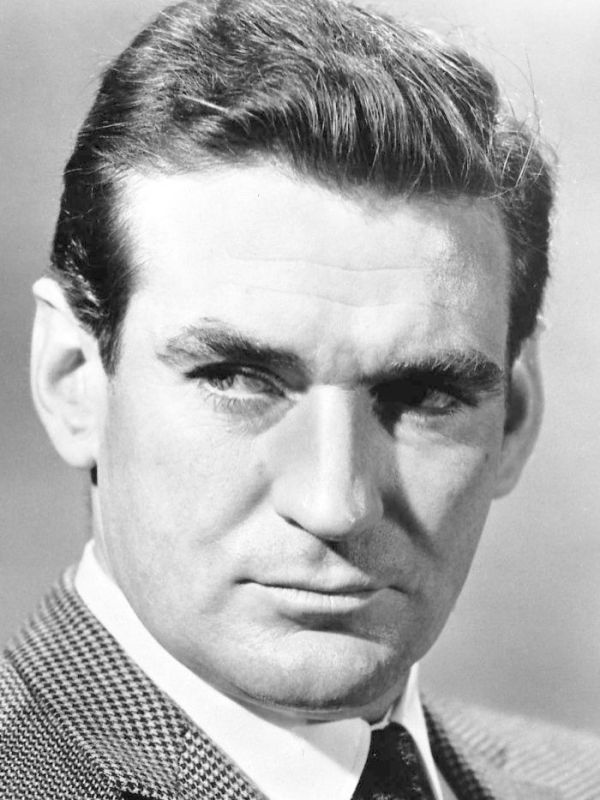 Rod Taylor
Rod TaylorAustralian actor Rod Taylor, botrn in 1930 too, passed away in Los Angeles aged 84, in January 2015. He was famous for his role in Alfred Hitchcock's 1963 horror movie The Birds. He was also known for performances in The Time Machineand The Train Robbers and more recently played Winston Churchill in Quentin Tarantino's Inglourious Basterds.
Born in Sydney, Taylor was a former Mona Vale Surf club member, vice-captain and boat rower. He was club captain in 1946 and 1947 and rowed surf boats that season after earning a bronze star.
Right Photo: Actor Rod Taylor, pictured in 1963 - Wikipedia.
Mona Vale SLSC Surf Boat Rowers represent Australia in Hawaii:
The team selected for Hawaii was printed in Volume 3 Number 10. June 1, 1939, page 14., of the Surf Life Saving Association of Australia: Surf in Australia.as follows:
J. R. Cameron (Captain-Instructor), H. R. Biddulph (Manly), C. R. Chapple (N. Bondi), R. Russell (Palm Beach), W. Furey (N. Steyne), L. McKay (N. Cronulla) , H. Doerner (Bondi), A. Imrie (Queensland), H. Scott (Newcastle), R. Dickson, W. Mackney and J. Harkness (Mona Vale), F. Braund (Palm Beach), F. Davis (Manly), A. Fitzgerald (N. Wollongong), L. Moreth (Manly).
'L. Moreth' was actually Clem Morath, of the Freshwater SLSC.
The item also stated:
'the R. and R. team for Hawaii is to be provided with military boots to race over the coral sea beds.' and 'Harold Spry, well-known Manly identity and ex-member of the Queenscliff club, will be visiting Hawaii at the same time as the surf team. Harold is an expert amateur movie photographer, and we hope he will be afforded all facilities to record the team's activities in film.'
They shipped per the s.s. "Monterey" on the 23rd June.
The July 1st Issue states:
Harold Spry, well-known Manly identity, has been appointed Hon. Photographer with the Australian team in Honolulu.
It was surprising to see so many old surfers at the send-off, including Freddie Williams (the father of surf shooters in Australia), Neville Cayley, Les Duff, Roy Doyle, George Millar, Stan Windon, Geoff Cohen and others.
A few lines about the event:
At the final day's surf carnival at Honolulu the Australians defeated the Hawaii surf boat team by a length, while Russell would have won the surf board race but for having to swerve near the finish to avoid an opponent, and so came second. SPORTING ITEMS (1939, July 28). The Richmond River Herald and Northern Districts Advertiser (NSW : 1886 - 1942), p. 7. Retrieved fromhttp://nla.gov.au/nla.news-article125943669
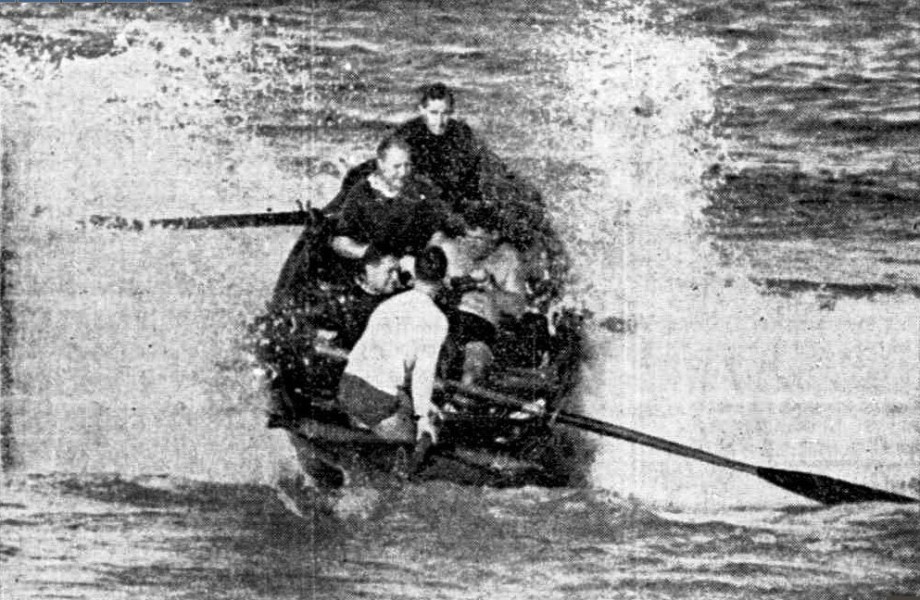
Surf Men In Action. Oarsmen in the Australian Surf Team take out a surf boat at Maroubra for a try-out. They leave for Honolulu on June 23 to compete at the Pacific Surf Games in July. Crew here is: F. Davis (sweep), J. B. Hardness (stroke), R. Dickson (3), G. Wray (2) (emergency who substituted for W. Mackney), F. Braund (bow). Surf Men In Action. (1939, June 18). Sunday Times (Perth, WA : 1902 - 1954), p. 3. Retrieved from http://nla.gov.au/nla.news-article59008010
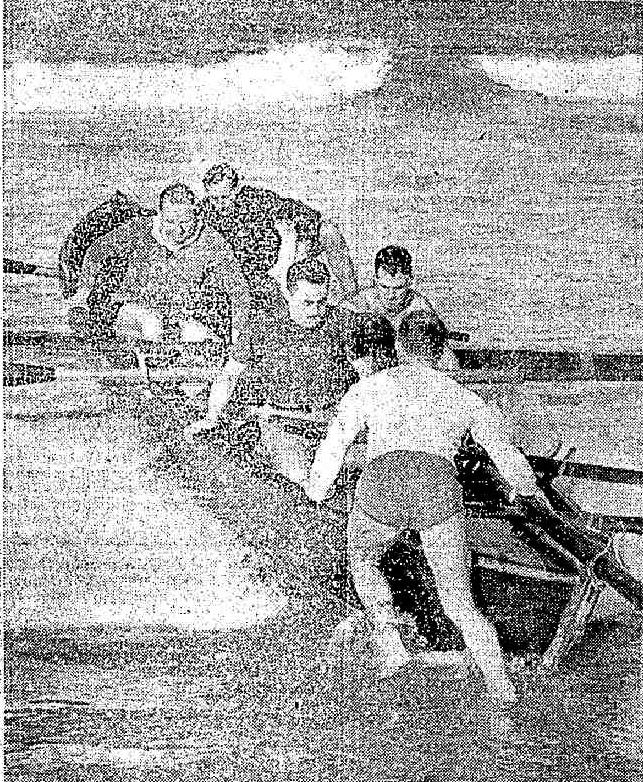
SURF BOAT CREW.— F. C. Davis (Manly) sweep, J. B. Harness (Mona Vale) stroke. R. A. Dickson (Mona Vale) No. 3, W. A. R. Mackney (Mona Vale) No. 2, F. N. Braund (Palm Beach) bow. HITCH OVER SURF TOUR. (1939, May 17). The Courier-Mail(Brisbane, Qld. : 1933 - 1954), p. 16. Retrieved from http://nla.gov.au/nla.news-article40843003
MONA VALE CARNIVAL -March Past Mona Vale 1 Newport 2 Palm Beach 3 Senior boat Whale Beach 1 Mona Vale 2 Board race S Dickson (Mona Vale) Ski J Woods (Avalon) 1 B Jackson (Bilgola) 2 R Howe (Bilgola) 3 Beach sprint Walsh (Newport) 1 J Harrison (Newport) Livingston (Newport) 3 Relay Newport 1 Newport B 2 Mona Vale 3. Details Of Sport (1951, January 29). The Sydney Morning Herald (NSW : 1842 - 1954), p. 6. Retrieved from http://nla.gov.au/nla.news-article18196803
Australia’s first Wildlife Reproductive Centre (WRC) was established in 1984, at the Taronga Western Plains Zoo, which opened in February 1977.
Zoo work
SYDNEY, Wednesday
— The NSW Minister to Lands and Forests, Mr. Fisher, has announced plans to develop the Taronga Zoo in Sydney and Dubbo's Western Plains Zoo at a cost of $925,000, $525,000 being spent at Dubbo and $400,000 at Taronga. Zoo work (1976, February 5). The Canberra Times (ACT : 1926 - 1995), p. 3. Retrieved from http://nla.gov.au/nla.news-article110800992
Dubbo open-plain zoo booming
A giraffe is the symbol of the Western Plains Zoo at Dubbo and all its literature features this drawing. The Western Plains Zoo is about six hours drive from Canberra, five kilo-metres south of Dubbo.
For those who have visited it, it does not need to be promoted. It is superb. For those yet to visit, these holidays could be just the time. According to its superintendent, Mr Bob Hogno, it is booming.
It opened in February 1977 and in its first five years had more than one million visitors. In 1982, it was visited by 210,000 people and was the only public attraction in NSW this year to have an increase in attendance, Mr Hogno said.
Western Plains was built on 500 hectares of land and was one of only three open-plains zoos in the world, the other two being Whipsnade, near London, and San Pasqual, near San Diego. The zoo is run by the NSW State Government in conjunction with Sydney's famous Taronga Zoo.
It has more than 700 animals, exhibited in areas closely simulating their natural habitat. They can be viewed from a sealed road by car or by bicycles which can be hired at the zoo.
"We believe our zoo is the only one where you can hire a bike to get around," Mr Hogno said. "We believe it would take at least half a day to see, but many need a whole day."
The enclosures vary in size from about half a hectare to 3.2 hectares and are separated by moats. There are animals representing all six continents. Visitors may walk close to the enclosures and there are trails where there are free ranging animals such as kangaroos, wallabies, deer and emus.
Mr Hogno said the animals were put into holding areas each night for their security and welfare and to keep them manageable. The zoo had been able to export some species, such as the Indian antelope, back to their place of origin.
It also held some rare white rhinoceroses.
The zoo had become attractive to a large variety of native birds which flew in mostly because of the easy supply of food.
There were free gas barbecues provided, set in four separate central areas.
The zoo is open from 9am to 6pm daily during the summer and costs $5 for adults and $2.50 for children and pensioners. Groups of more than 12 receive a concession. Dubbo open-plain zoo booming (1983, December 26). The Canberra Times (ACT : 1926 - 1995), p. 7. Retrieved from http://nla.gov.au/nla.news-article116403125
Zoo Facts
•Opened 28 February 1977
•Size: 300 hectares
•Original cost of development: $2,800,500
•The Zoo site was formerly an army camp during World War II
•First Zoo in Australia to be constructed on the “open range” principle, with visitors separated from the animals by concealed moats and fences
•Zoo circuit is 6km long
•Is the only Zoo in Australia you can drive a car, ride a bike, hire a cart or walk around
•Renowned for breeding rare and endangered species including the Southern Black Rhinoceros
•Zoofari Lodge was the first “in zoo” accommodation established in Australia in 1995
•It’s the only Zoo in Australia where visitors can see three species of rhinos (Black Rhinoceros, White Rhinoceros and Greater One-horned Rhinoceros)
Bruce - Her Majesty, Queen Elizabeth II
PRESENTATION OF COLOURS AT DUNTROON
Efforts are being made by the Royal Military College authorities to allow the public of Canberra to see Princess Elizabeths present new colours to the Corps of Staff Cadets on Thursday April 17.
All problems regarding accommodation for the public adjacent to the College parade ground have not yet been overcome, and an announcement concerning the admission of the public cannot be made until they are solved.
Efforts are being made to obtain tiered seating for the public. If this is available, an announcement will be made within a few days.
Her Royal Highness and the Duke of Edinburgh will arrive at the College at 10 30 a.m. on April 17.
They will be met by the Minister for the Army (Mr. Francis) who will present the Commandant of the College, Major General R. N. L. Hopkins.
A Royal Salute will be fired, and Their Royal Highnesses will inspect 230 cadets on parade.
After the inspection, the old Colours, which were presented to the College in 1927 by King George VI, will be trooped. The new Colours will be marched on to the parade ground and will be consecrated.
Her Royal Highness will present the new Colours to the Corps, and address the Cadets.
The Commandant will reply to the address of Her Royal Highness.
The Corps will give a display of slow and quick time marching, after which it will advance in review order.
On completion of the ceremony on the parade ground, Their Royal Highnesses, escorted by the Commandant, will visit Duntroon House for morning tea. PRESENTATION OF COLOURS AT DUNTROON (1952, January 25). The Canberra Times (ACT : 1926 - 1995), p. 4. Retrieved from http://nla.gov.au/nla.news-article2847168
Elizabeth proclaimed Queen of Australia
CANBERRA, Friday— With steady rain falling the Governor-General (Sir William McKell) stood bareheaded on the steps of Parliament House to-day and proclaimed Queen Elizabeth the Second as the Queen of Australia.
Sir William read the proclamation from almost the same spot as where the late King, as the Duke of York, opened the Australian Parliament at Canberra in 1927.
THE proclamation, which Sir William McKell read from a special black-edged Gazette, was as follows:
'Whereas it hath pleased Almighty God to call to His mercy our late Sovereign Lord, King George VI., of blessed and glorious memory, by whose decease the Crown solely and rightfully comes to the high and mighty Princess Elizabeth Alexandra Mary, We therefore, Sir William John McKell, Governor-General and Commander -in-Chief in and over the Commonwealth of Australia, and members of the Federal Executive Council, do now hereby with one voice and consent of tongue and heart, publish and proclaim that the high and mighty Princess Elizabeth Alexandra Mary, now, by the death of our late Sovereign of happy memory, becomes Queen Elizabeth II., by the grace of God. Queen of this realm and all her other realms and territories, head of the Commonwealth, defender of the faith, supreme liege lady in and over the Commonwealth of Australia, to whom her lieges do acknowledge all faith and constant obedience with hearty and humble affection, 'Beseeching God, by whom lyings and Queens do reign, to bless Royal Princess Elizabeth II. with long and happy years to reign over us.
'Given at Canberra, this seventh day of February, in the year of our Lord, 1952, and in the first year of Her Majesty's reign.
'Signed, W. J. McKell. Governor-General.
The proclamation was also signed by 14 Cabinet Ministers.
Short Ceremony
A short, but impressive ceremony, marked the proclamation. Before the arrival of Sir William, units from the Royal Military College, Duntroon, and the R.A.N. and R.A.A.F., formed a guard of honour outside Parliament House.
On arrival, Sir William inspected the guard, and was then met by Mr. Menzies, representing H e r Majesty's Australian Government, and Dr. Evatt, representing Her Majesty's Opposition. Sir William then mounted the front steps of Parliament House, and amid flashes of newspaper photographers and camera flashlights, read the proclamation. The Speaker of the House of Representatives, Mr. Cameron, members of Cabinet, and the majority of the Diplomatic Corps, many in national dress, were at the top of the steps awaiting Sir William's arrival. Many On Lawns4 On the lawns flanking the approach to Parliament House, and surrounding the statue of King George V.. more than 8000 school children and hundreds of Government employees and private citizens stood silent and awestruck, as they heard their new Sovereign officially pronounced. The ceremony was brought to a conclusion by the playing of 'God Save the Queen,' which immediately brought a spontaneous response from the school children, who sang the last bars with the band.
Crowd Packs Macquarie Street For Sydney Ceremony
SYDNEY, Fri. — A crowd of more than 4000 packed Macquarie street this afternoon, when State Governor, Lieut-General Sir J o h n Northcott, made the proclamation of Her Majesty. Queen Elizabeth II., from the verandah of Parliament House. The proclamation war made at 5 p.m. By 4.10 p.m. many people had already taken a stand opposite Parliament House.
By 4.45 p.m., Macquarie street, from Martin Place to Hunter street, was packed, while workers in the buildings opposite Parliament House lined windows and several roofs.
Colourful
The ceremony of proclamation, one of the most colourful seen in Sydney for many years, lasted only 12 minutes. Many spectators seemed disappointed at its briefness. The Governor arrived at Parliament House, escorted by N.S.W. Mounted Police. As he stepped from his car and was welcomed to Parliament House by the Premier, Mr. McGirr, the Police Band played the National Anthem. Mr. Mr. McGirr escorted the Governor from the entrance to the verandah of the House, which was draped in purple and black mourning. Royal Fanfare Before the Governor read the proclamation. Police Band trumpeters played a Royal fanfare. A hush fell on the crowd as the Governor began to read the proclamation in slow, measured tones. The proclamation was signed by the Governor (Lieut.-General Sir John Northcott), Lieut-Governor and Chief Justice (Hon. K. W. Street), Premier and Colonial Treasurer (James McGirr), and the Deputy Premier and Minister for Public Works and Local Government (J. J. Cahill). .Assembled on Parliament House verandah during the reading of the proclamation were State Cabinet Ministers, the Speaker of the House, :i representative of the Opposition Leader, the State Country Party Leader, civic leaders, heads of churches, legal representatives, Dean of the Consular Corps, heads of the armed services, and other Government representatives. Hushed Silence Throughout the ceremony there was a hushed silence over the crowd. Not a cheer or applause of any sort was heard after the official proclamation had been made Men stood hatless in the crowd, and many women bowed their heads.
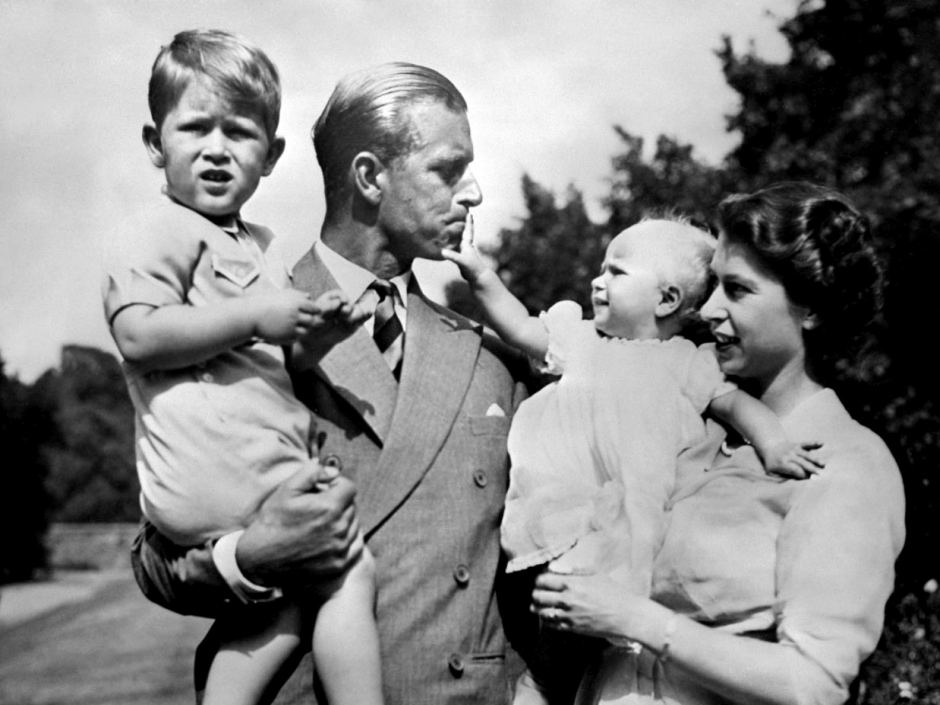
Elizabeth II., Queen of Australia, with her husband, the Duke of Edinburgh, and their two children, Prince Charles and Princess Anne. The Duke is Prince Consort. Prince Charles is Heir Apparent to the Throne.
ELIZABETH PROCLAIMED QUEEN OF AUSTRALIA (1952, February 9). Daily Examiner (Grafton, NSW : 1915 - 1954), p. 1. Retrieved from http://nla.gov.au/nla.news-article195524764
The stress of WWII had taken its toll on the King George's health, made worse by his heavy smoking and subsequent development of lung cancer among other ailments, including arteriosclerosis and Buerger's disease. A planned tour of Australia and New Zealand was postponed after the King suffered an arterial blockage in his right leg, which threatened the loss of the leg and was treated with a right lumbar sympathectomy in March 1949.
His elder daughter Elizabeth, the heir presumptive, took on more royal duties as her father's health deteriorated. The delayed tour was re-organised, with Elizabeth and her husband, the Duke of Edinburgh, taking the place of the King and Queen. The King was well enough to open the Festival of Britain in May 1951, but on 23 September 1951, his left lung was removed by Clement Price Thomas after a malignant tumour was found. In October 1951, Princess Elizabeth and the Duke of Edinburgh went on a month-long tour of Canada; the trip had been delayed for a week due to the King's illness. At the State Opening of Parliament in November, the King's speech from the throne was read for him by the Lord Chancellor, Lord Simonds. His Christmas broadcast of 1951 was recorded in sections, and then edited together.
On 31 January 1952, despite advice from those close to him, the King went to London Airport to see off Princess Elizabeth, who was going on her tour of Australia via Kenya. On the morning of 6 February, George VI was found dead in bed at Sandringham House in Norfolk. He had died from a coronary thrombosis in his sleep at the age of 56. His daughter flew back to Britain from Kenya as Queen Elizabeth II.
SURF CARNIVAL BIG ATTRACTION
TO QUEEN AND DUKE
Overstayed 45 minutes
FROM ARTHUR RICHARDS
SYDNEY (by teleprinter)— The Queen was so engrossed with her first surf carnival yesterday that she and her husband overstayed their- scheduled half-hour visit to Bondi Beach by 45 minutes. The carnival, with yesterday's Randwick race meeting, was the most successful Royal Tour entertainment yet staged.
A crowd of 150,000 cheered themselves hoarse when the Queen and the Duke arrived two minutes behind schedule. But it was a crowd determined to be on its best behaviour, and saved the Queen the embarrassment of being continually stared at — with or without binoculars. Elizabeth, Queen of England and the Dominions, and Philip, Duke of Edinburgh, saw the surf carnival as two more people in a crowd of ardent surf fans. They may not have understood the intricacies of surf sports as well as the other spectators, but, they enjoyed it just as much. Was engrossed Most of the crowd, a record for Bondi, were young people in swimming suits or gaily coloured beach clothes. Shaded by a large white parasol, Her Majesty frequently turned to officials and questioned them on the novelty of surf boat races, surfboard riding, shooting breakers, and beach rescues. She and the Duke leaned forward on their chairs trying to follow several events at the one time.
A fine, rolling surf provided ideal conditions for husky surfmen from all over Australia and New Zealand to 'put on a show.' Really new Promoters of the carnival said the Queen's obvious interest in the beach events exceeded their wildest dreams. British correspondents who have accompanied the Royal tour from England said the display was the most novel, interesting and exciting show the Queen and the Duke had yet seen. They said the carnival was something completely new to the Queen, and something that could not be exactly duplicated anywhere in the world. The stands in the reserved carnival' area were packed an hour before the Queen's arrival. Thousands of young people in 'casual summer clothes and swim suits spilled on to burning roads from milk bars and cafes as the Royal car arrived from Randwick. Many spectators had been on the beach since sun-up, their bodies showing pink despite glistening sun oil and tan. The Queen pointed excitedly to the more dramatic scenes of boats battling the moderate but dumping surf, and at times laughed outright at the dilemma of two lifesavers staging a pillow fight on a slippery pole.
Extra surf boat races were run off during the unscheduled time the Royal party spent on the beach. The programme for the afternoon was well ahead of time before the Queen and the Duke of Edinburgh arrived, and they missed most of the giant march past — thought to be the biggest seen in Australia.
After a minute in the hot dazzling sunlight, the Queen who was wearing sun glasses, asked for a sunshade, and the Surf Life-Saving Association president (Mr. Ken Watson) held it for her during her stay. The Duke, who arrived bare-headed, donned a brown felt hat.
Tour beach
A wide series of events was run off simultaneously. They included surf boat races, - swimming races, rescues.-racing on the beach, surf boards and surf skis. . It was a great spectator day, with a light breeze to reduce the worst of the heat. Occasional heavy dumpers made problems for the competitors and high entertainment for the crowd, including the Queen and the Duke. The crowd's natural interest in the Queen mainly was limited to a quick glance towards the Royal dais after any particularly dramatic or humorous incident, to see. how Her Majesty was enjoying it.
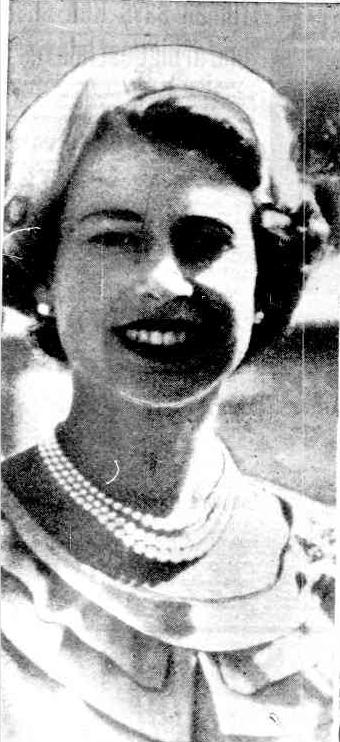
DELIGHTED smile from the Queen at yesterday's Bondi surf carnival, when she was engrossed in the novelties of surf boat racing, surfboard riding, shooting breakers, and rescue techniques.
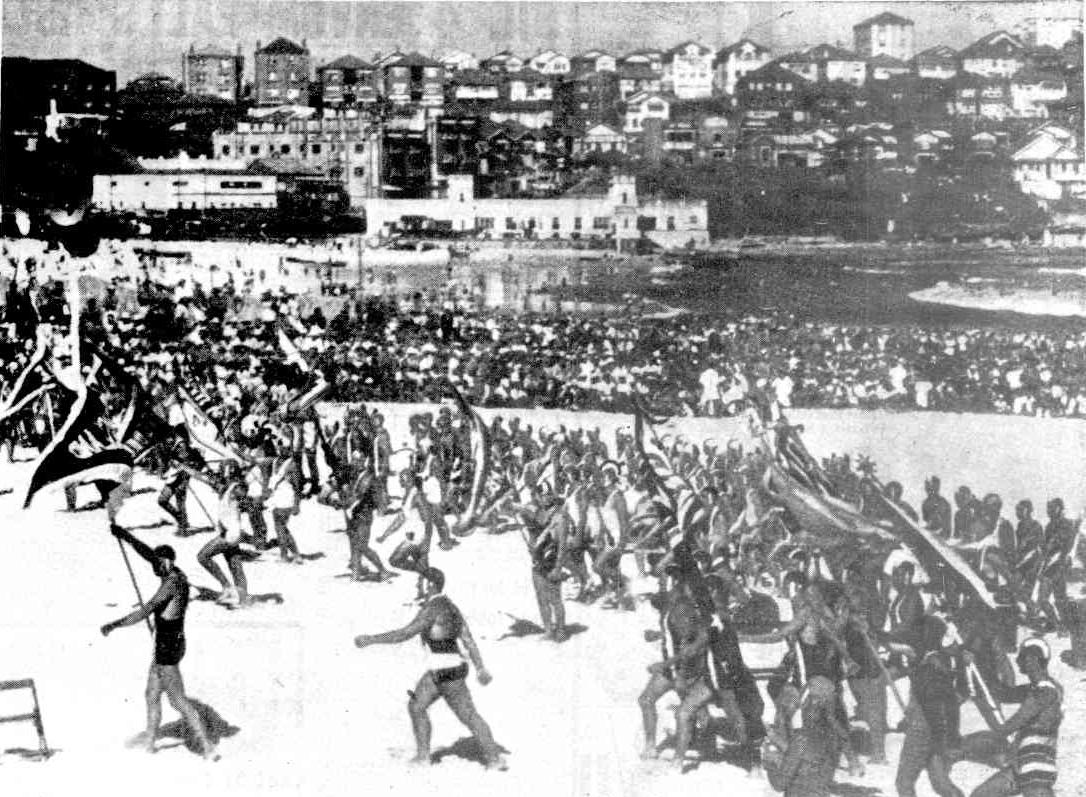
Photo: IMPRESSIVE march past of lifesavers yesterday at Bondi's surfing display for the Queen and the Duke of Edinburgh. Organrsers later reported the Queen's alert interest exceeded their wildest dreams. A thoughtful crowd of 150,000 let the Queen and the Duke enjoy, without stares, the displays as two more people in a crowd. SURF CARNIVAL BIG ATTRACTION TO QUEEN AND DUKE (1954, February 7).Sunday Mail (Brisbane, Qld. : 1926 - 1954), p. 3. Retrieved from http://nla.gov.au/nla.news-article100184811
Vast Crowd Sees the Queen at Bondi Surf Carnival
A VAST CROWD packed Bondi beach and vantage points on nearby headlands when the Queen and the Duke of Edinburgh attended Saturday's spectacular Royal surf carnival.
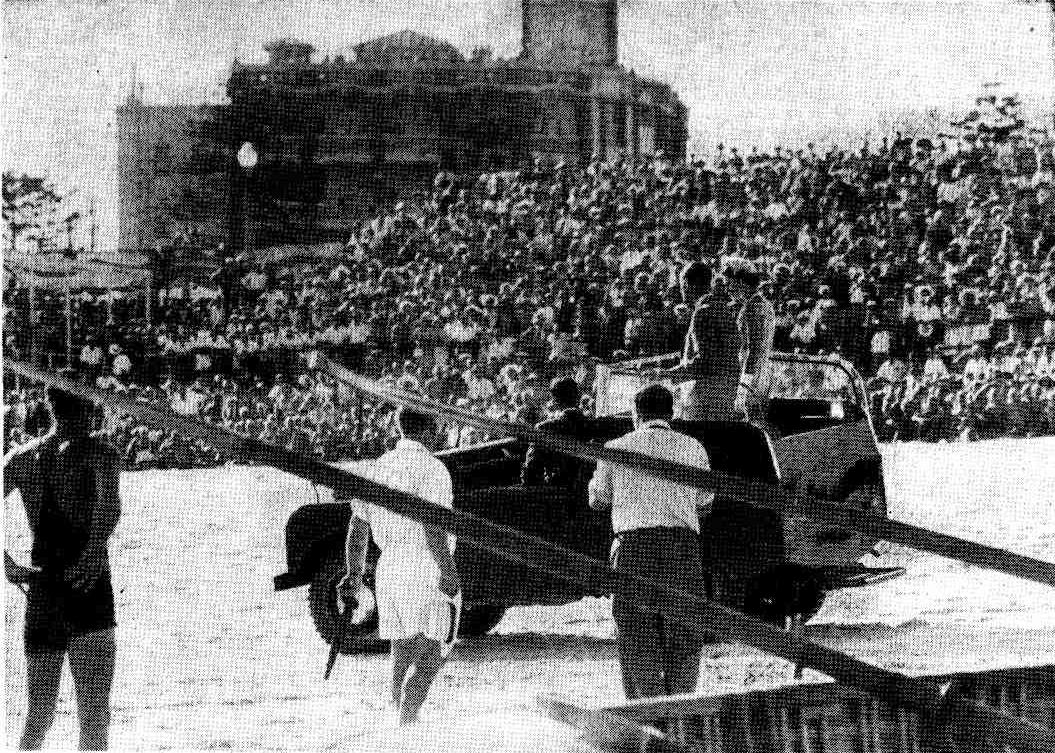
TOP: the Royal Land Rover rolls slowly over the glistening sands of the beach. LOWER: The Queen and the Duke of Edinburgh chat with a life saver during the carnival.
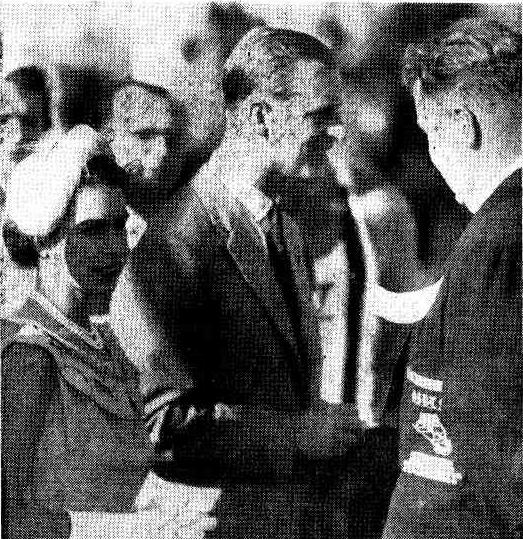
Vast Crowd Sees the Queen at Bondi Surf Carnival (1954, February 8). The Age (Melbourne, Vic. : 1854 - 1954), p. 3. Retrieved fromhttp://nla.gov.au/nla.news-article206083887
